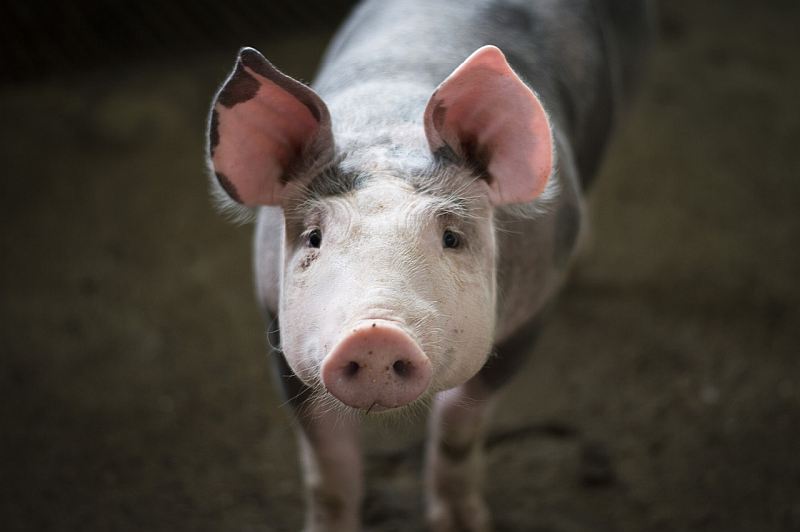Have you ever wondered what the world looks like through a pig’s eyes? Let’s dive into the intriguing world of pig vision.
You’ll discover can pigs see color, debunk common misconceptions, and learn the science behind color perception.
We’ll compare pig vision to human vision and explore the implications of color vision in pigs.
Get ready to challenge what you thought you knew about our porcine friends.
Key Takeaways
- Pigs have dichromatic vision, perceiving blue and green colors.
- Pigs are not colorblind but have a limited color range compared to humans.
- Pig retina structure and their two types of photoreceptor cells determine color perception.
- Limited color vision in pigs affects their communication and behavioral responses.
Understanding Pig Vision
How well do you think pigs see the world around them?
Despite their small eyes and long snouts, pig eyesight is more complex than you imagine. They’ve got dichromatic vision, meaning they see two primary colors – blue and green. But don’t mistake this for a limitation. It’s an impressive vision adaptation that allows pigs to spot predators or food in various light conditions.
Even more, they perceive movements and contrasts exceptionally well. This acute sensitivity helps them react quickly to changes in their environment.
Debunking Common Misconceptions
Despite the prevalence of misinformation, understanding pig vision isn’t as black and white as you’d think. Let’s debunk a common pig myth: all pigs are colorblind. It’s easy to lump pigs together with other colorblind animals, but scientific studies contradict this belief.
While it’s true that pigs don’t have the vivid color range we humans enjoy, they aren’t entirely colorblind. Pigs have dichromatic vision, meaning they can distinguish two primary colors, blue and yellow. They can’t see red or green, but that doesn’t mean they live in a grayscale world.
The Science Behind Color Perception
Understanding the science behind color perception can help you appreciate the dichromatic vision of pigs even more. The key lies in the pig retina structure, precisely the types of photoreceptor cells present.
Humans have three types of such cells (cones) that detect red, blue, and green light. On the other hand, Pigs only have two – attuned to blue and yellow wavelengths. This is where Color Spectrum Analysis comes into play.
By examining how different wavelengths of light interact with these photoreceptor cells, scientists have discovered that pigs see a more limited color range than humans. In other words, they see the world through a dichromatic lens.
Comparative Analysis: Human Vs Pig Vision
In comparing your vision to a pig’s, it’s quite clear that you’ve got the upper hand when experiencing the full array of hues. Humans can distinguish millions of colors, while pigs are dichromatic, seeing fewer colors, more similar to a human with red-green color blindness.
But don’t feel too superior just yet. Pigs possess impressive night vision, significantly better than ours, thanks to a higher number of rod cells that are sensitive to low light. They also have a faster vision adaptation speed, adjusting quickly to changes in light intensity. However, they lack the fovea, a region of the human eye that provides sharp, central vision.
Implications of Color Vision in Pigs
So, you’re probably wondering how this limited color vision impacts a pig’s daily life and behavior.
Despite not having a full spectrum of color vision like humans, pigs interact and communicate effectively within their environment. The limited color vision influences pig communication, as they rely more on sound, smell, and touch.
The perception of blues and greens can trigger behavioral shifts. For instance, they can recognize certain colored objects linked to food or danger, which guides their responses. Green, being prevalent in their natural environment, might help them identify edible vegetation.
Though not having rich color vision, pigs have adapted their behavior to effectively utilize their available visual spectrum, enhancing their survival capabilities.
Frequently Asked Questions
How Does the Pig’s Environment Affect Its Vision?
Your pig’s environment influences its vision, particularly its nocturnal vision. Dim light conditions enhance vision-related behaviors, aiding in food foraging and navigation. However, overly bright or rapidly changing light conditions can confuse and disorient them.
What Other Animals Have Similar Vision to Pigs?
You’re curious about pig vision comparisons. Well, pigs have a dichromatic vision similar to dogs and cats. This unique animal eyesight allows them to see blues and yellows but not the full spectrum of colors.
Are There Any Breeds of Pigs That Have Different Color Perception?
No specific breed variations impact pig vision genetics significantly. All pigs, regardless of breed, share similar color perception variations, seeing primarily in shades of blue and green, much like humans with red-green color blindness.
How Does a Pig’s Vision Develop as It Ages?
As a pig ages, its vision matures. You’ll notice changes in its eye health. Initially, their sight isn’t perfect, but as they grow, they develop a more defined perception of their surroundings.
Can a Pig’s Vision Be Improved or Worsened Under Certain Conditions?
Yes, a pig’s vision can be altered under certain conditions. Harsh lighting or poor nutrition can deteriorate pig vision, while a balanced diet and proper care can enhance their visual capabilities.
Conclusion
Contrary to popular belief, you now know pigs can see color, just not as vividly as humans.
Pigs’ dichromatic vision allows them to distinguish blues and greens, unlike the full spectrum we perceive.
This fascinating twist on our understanding of pig biology and behavior offers unique insights into their world.
So next time you spot a pig, remember, they’re viewing the world in a different, albeit less colorful, light.

